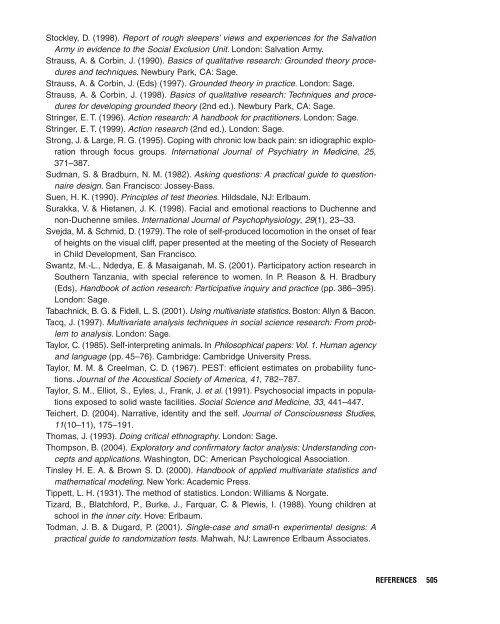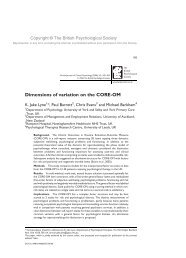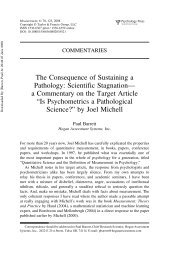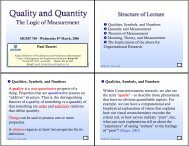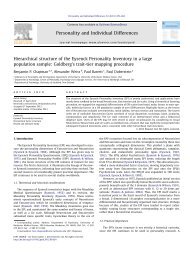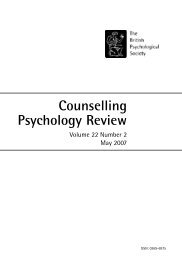Psychophysiological Methods - Paul Barrett
Psychophysiological Methods - Paul Barrett
Psychophysiological Methods - Paul Barrett
- No tags were found...
You also want an ePaper? Increase the reach of your titles
YUMPU automatically turns print PDFs into web optimized ePapers that Google loves.
Breakwell-3389-Reference.qxd 2/7/2006 9:03 PM Page 505Stockley, D. (1998). Report of rough sleepers’ views and experiences for the SalvationArmy in evidence to the Social Exclusion Unit. London: Salvation Army.Strauss, A. & Corbin, J. (1990). Basics of qualitative research: Grounded theory proceduresand techniques. Newbury Park, CA: Sage.Strauss, A. & Corbin, J. (Eds) (1997). Grounded theory in practice. London: Sage.Strauss, A. & Corbin, J. (1998). Basics of qualitative research: Techniques and proceduresfor developing grounded theory (2nd ed.). Newbury Park, CA: Sage.Stringer, E. T. (1996). Action research: A handbook for practitioners. London: Sage.Stringer, E. T. (1999). Action research (2nd ed.). London: Sage.Strong, J. & Large, R. G. (1995). Coping with chronic low back pain: sn idiographic explorationthrough focus groups. International Journal of Psychiatry in Medicine, 25,371–387.Sudman, S. & Bradburn, N. M. (1982). Asking questions: A practical guide to questionnairedesign. San Francisco: Jossey-Bass.Suen, H. K. (1990). Principles of test theories. Hildsdale, NJ: Erlbaum.Surakka, V. & Hietanen, J. K. (1998). Facial and emotional reactions to Duchenne andnon-Duchenne smiles. International Journal of Psychophysiology, 29(1), 23–33.Svejda, M. & Schmid, D. (1979). The role of self-produced locomotion in the onset of fearof heights on the visual cliff, paper presented at the meeting of the Society of Researchin Child Development, San Francisco.Swantz, M.-L., Ndedya, E. & Masaiganah, M. S. (2001). Participatory action research inSouthern Tanzania, with special reference to women. In P. Reason & H. Bradbury(Eds), Handbook of action research: Participative inquiry and practice (pp. 386–395).London: Sage.Tabachnick, B. G. & Fidell, L. S. (2001). Using multivariate statistics. Boston: Allyn & Bacon.Tacq, J. (1997). Multivariate analysis techniques in social science research: From problemto analysis. London: Sage.Taylor, C. (1985). Self-interpreting animals. In Philosophical papers: Vol. 1. Human agencyand language (pp. 45–76). Cambridge: Cambridge University Press.Taylor, M. M. & Creelman, C. D. (1967). PEST: efficient estimates on probability functions.Journal of the Acoustical Society of America, 41, 782–787.Taylor, S. M., Elliot, S., Eyles, J., Frank, J. et al. (1991). Psychosocial impacts in populationsexposed to solid waste facilities. Social Science and Medicine, 33, 441–447.Teichert, D. (2004). Narrative, identity and the self. Journal of Consciousness Studies,11(10–11), 175–191.Thomas, J. (1993). Doing critical ethnography. London: Sage.Thompson, B. (2004). Exploratory and confirmatory factor analysis: Understanding conceptsand applications. Washington, DC: American Psychological Association.Tinsley H. E. A. & Brown S. D. (2000). Handbook of applied multivariate statistics andmathematical modeling. New York: Academic Press.Tippett, L. H. (1931). The method of statistics. London: Williams & Norgate.Tizard, B., Blatchford, P., Burke, J., Farquar, C. & Plewis, I. (1988). Young children atschool in the inner city. Hove: Erlbaum.Todman, J. B. & Dugard, P. (2001). Single-case and small-n experimental designs: Apractical guide to randomization tests. Mahwah, NJ: Lawrence Erlbaum Associates.REFERENCES505


